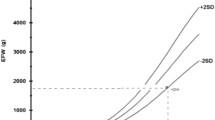Abstract
Purpose
This retrospective study evaluated the pregnancy rates of 23 couples with male factor infertility due to traumatic spinal cord injury (N = 21), multiple sclerosis (N = 1) or transverse myelitis (N = 1).
Methods
Ovulation induction by clomiphene citrate or gonadotropins was used in combination with intrauterine insemination as an initial approach for assisted conception in all but one couple.
Results
Six pregnancies occurred in 60 cycles of intrauterine insemination (mean of 2.6 cycles). In this group, the cumulative pregnancy rate was 26%. Six couples who failed after a total of 33 intrauterine insemination cycles (mean of 5.5 cycles), and 1 couple with no previous intrauterine insemination cycles, initiated 10 cycles of in vitro fertilization (mean of 1.4 cycles). In this group, five pregnancies occurred. The pregnancy rate was 71%.
Conclusion
We conclude that ovulation induction in combination with intrauterine insemination offers an effective initial therapy of severe male factor infertility due to spinal cord injury.
Similar content being viewed by others
References
Stover SL, Fine PR (eds): Spinal Cord Injury: The Facts and Figures. The University of Alabama, Birmingham, 1986
Bors E, Comarr AE: Neurological disturbances of sexual function with special reference to 529 patients with spinal cord injury. Urol Surv 1960;10:191–222
Bennett CJ, Seager SW, Vasher EA, McGuire EJ: Sexual dysfunction and electroejaculation in spinal cord injury: Review. J Urol 1988;139:453
Brackett NL, Lynne CM, Weizman MS, Bloch WE, Abae M: Endocrine profiles and semen quality of spinal cord injured males. J Urol 1994;151:114–119
Perkash I, Martin DE, Warner H, Blank MS, Collins DC: Reproductive biology of paraplegics: Results of semen collection, testicular biopsy and serum hormone evaluation. J Urol 1988;44:284–287
Denil J, Ohl DA, Menge AC, Keller LM, McCabe M: Functional characteristics of sperm obtained by electroejaculation. J Urol 1992;147:69–72
Russell JK: Artificial insemination (husband) in the management of childlessness. Lancet 1960;2:1223–1225
Barwin BN: Intrauterine insemination of husband semen. J Reprod Fertil 1974;36:101–105
Dicket RP, Olar TT, Taylor SN, Curole MD, Rye PH: Relationship of follicle number of other factors to fecundability and multiple pregnancy in clomiphene citrate-induced intrauterine insemination cycles. Fertil Steril 1992;57:613–619
Kemmann E, Bohrer M, Shelden R, Fiasconaro G, Beardsly L: Active ovulation management increases the monthly probability of pregnancy occurrence in ovulatory women who receive intrauterine insemination. Fertil Steril 1987;48:916–920
Melis GB, Paoletti AM, Stringini F, Fabris FM, Canale D, Fioretti P: Pharmacologic induction of multiple follicular development improved the success rate of artificial insemination with husband's semen in couples with male-related or unexplained infertility. Fertil Steril 1987;47:441–445
Cruz RI, Kemmann E, Brandeis VT, Becker KA, Beck M, Beardsly L, Shelden R: A prospective study of intrauterine insemination of processed sperm from men with oligosasthenospermia in supraovulated women. Fertil Steril 1986;46:673–677
Ho PC, So WK, Chan YF: Intrauterine insemination after ovarian stimulation as a treatment for sub-fertility because of subnormal semen: A prospective randomized controlled study. Fertil Steril 1992;58:995–999
Chaffkin LM, Nulsen JC, Luciano AA, Metzger DA: A comparative analysis of the cycle fecundity rates associated with combined human menopausal gonadotropin (hMG) and intrauterine insemination (IUI) versus either hMG or IUI alone. Fertil Steril 1991;55:252–257
Society for Assisted Reproductive Technology. Fertil Steril 1994;62:1121–1128
Toledo AA, Tucker MJ, Bennett JK, Green BG, Kort HI, Wiker SR, Wright G: Electroejaculation in combination with in vitro fertilization and gamete micromanipulation for treatment of anejaculatory male infertility. Am J Obstet Gyn 1992;167:322–325
Halstead LS, VerVoort SM, Seager SWJ: Rectal probe electrostimulation in the treatment of anejaculatory spinal cord injured men. Paraplegia 1987;25:120–129
McClure RD, Nunes L, Tom R: Semen manipulation: Improved sperm recovery and function with a two-layer Percoll gradient. Fertil Steril 1989;51:874–879
Brackett NL, Lynne CM, Bloch WE: unpublished data
Redgment CJ, Yang D, Tsirigotis M, Yazdani N, al Shawaf T, Craft IL: Experience with assisted fertilization in severe male factor infertility and unexplained failed fertilization in vitro. Hum Reprod 1994;9:680–683
Van Steirteghem AC, Nagy Z, Joris H, Liu J, Staessen C, Smitz J, Wisanto A, Devroey P: High fertilization and implantation rates after intracytoplasmic sperm injection. Hum Reprod 1993;8:1061–1066
Author information
Authors and Affiliations
Rights and permissions
About this article
Cite this article
Brackett, N.L., Abae, M., Padron, O.F. et al. Treatment by assisted conception of severe male factor infertility due to spinal cord injury or other neurologic impairment. J Assist Reprod Genet 12, 210–216 (1995). https://doi.org/10.1007/BF02211801
Received:
Accepted:
Issue Date:
DOI: https://doi.org/10.1007/BF02211801




